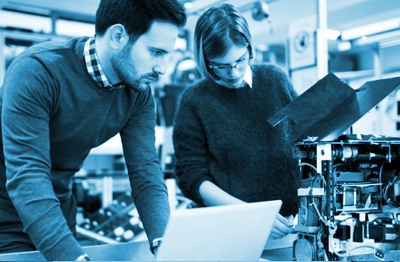Study
Overview of the courses offered by the Chair of EMA
Vehicle Technology
Objectives and competences:
- Fundamentals of combustion engines
- Technical application of combustion engines
- Advantages and disadvantages of the combustion engine
- Importance of combustion engines for drive systems
Contents:
- Definitions
- Working methods
- Thermodynamics
- Crank drive
- Mass balance
- Supercharging
- emissions
- Technical application of combustion engines
Engine and vehicle acoustics
Aims and competences:
- Teaching the basics of acoustics,
- Significance of sound (noise) for the environment and product comfort
- Methods for sound measurement and assessment
- Derivation of measures to minimise noise
- Application of engine and vehicle acoustics
Contents:
- Fundamentals of acoustics, airborne and structure-borne sound
- Noise (limit and guide values, noise effects)
- Psychoacoustics
- Room acoustics, acoustic measuring rooms
- Acoustic measurement technology Evaluation methods
- Engine and vehicle acoustics
- Methods and measures for noise reduction
Fuels and energy sources
Objectives and competences:
Use of different energy sources, depending on the combustion processes or drive systems
Energy sources and energy storage technologies depending on
- availability
- environmental compatibility
- sustainability
- economic efficiency and technical complexity
Contents:
- Energy sources and energy storage systems for vehicles
- Fossil fuels (liquid and gaseous)
- Biogenic fuels, synthetic e-fuels
- Energy storage: electrochemical fundamentals and principles of primary and secondary elements, selected functional examples;
- Scaling and battery management for mobile systems; current developments
Hearing acoustics
Aims and competences:
- Knowledge of basic hearing acoustics parameters
- Basic knowledge of measurement methods for hearing acoustics
- Basic knowledge of the perceptual characterisation of environmental sounds
Contents:
- Fundamentals and basic concepts of hearing acoustics; perceptual variables and their relationship to physical parameters;
- Differential perception; masking;
- Calculation methods for determining loudness as a fundamental perceptual variable in hearing acoustics;
- Perception of level fluctuations and their significance in the evaluation of technical sounds, e.g. roughness;
- Characterisation of the perception of tonal sounds, i.e. pitch, tonality, timbre; application to engine sounds;
- binaural auditory perception
Hydraulic and pneumatic systems - pumps and compressors
Objectives and competences:
- Fundamentals of reciprocating pumps/compressors and rotary piston pumps/compressors,
- Constructive design of positive displacement machines,
- Control of positive displacement machines
- Fundamentals of hydraulics and pneumatics
Contents:
- Design and function of positive displacement machines
- Thermodynamic processes
- Physical principles (hydrostatics, resistances, pressure build-up) and fluid technology symbols - Types and structure of pumps, suction behaviour of pumps, control units
- Fundamentals of pneumatics (elements of pneumatic systems, system circuit diagram)
- Design of various pneumatic components, e.g. valves (directional, shut-off, flow and pressure valves)
- Pneumatic control systems
Fundamentals of vehicle technology
Goals and competences:
- Novel mobility concepts
- Fundamentals of modelling and analysis of motor vehicles
- Fundamentals of vehicle dynamics
- Basic understanding of the drivetrain and its components
- Basic understanding of the chassis
Contents:
- Traffic development / requirements for motor vehicles
- Mobility concepts (small vehicles, micromobiles, sharing approaches,...)
- Vehicle physics (driving resistance, tyre models, vehicle models,...)
- Drives and components in the drive train
- Chassis (brakes, wheel suspensions, steering,... )
- Specifics of vehicle sensors
Vehicle emissions
Objectives and competences:
- Knowledge of the different sources of vehicle emissions
- Analysing the requirements in vehicle development
- Ability to design vehicle architectures
- Development planning
- Basic understanding of sustainability
Contents:
- Types of emissions (gases, dust, noise, light, ...)
- Emissions vs. immissions
- Effects on people and the environment
- Legal regulations
- The concept of sustainability
- Climate-relevant emissions and the greenhouse effect
- Origin and reduction of vehicle emissions
- Exhaust emissions & measures to reduce emissions & exhaust aftertreatment
Simulation of internal engine processes - injection, combustion and pollutant formation
Objectives and competences:
- Application of simulation
- Structure of the various injection systems
- Advantages and disadvantages of the various injection systems
Contents:
- Introduction and legislation, presentation of development chain: 1-D and 3-D tools
- Overall system simulation: modelling vehicle and subsystems
- Design of engine concept (incl. exhaust gas turbocharger concept) Modelling of injection system
- Injection spray and mixture formation
- Phenomenological modelling of combustion and pollutant formation
- Workshops 1D
- Engine process simulation (using GT-Power as an example)
Vehicle system design
Goals and competences:
- Analysing the requirements in vehicle development
- Ability to design vehicle architectures
- Insight into the development processes
- Fundamentals of development planning
- Basic understanding of sustainability
Contents
- Product development process PEP
- Vehicle platforms and construction kits
- Organisation and process of vehicle development
- Requirements management Legal boundary conditions
- Vehicle architectures (BEV / HEV / FCEV vs. conventional vehicle)
- Components (drive technology, storage technology)
- Software management / connectivity Safety / virtual infrastructure for the vehicle
- Functional safety Testing, validation of prototypes
- Production conditions, sales and after-market
- Recycling Life-Cycle Assessment (LCA)
Hydrogen technology and drives
Objectives and competences:
- Analysing the requirements for the alternative fuel hydrogen
- Assessment of sustainability potential
- Assessment of safety standards for hydrogen
- Basics of the technical possibilities
- Contribution of hydrogen to the energy and transport transition
Contents:
- Introduction to hydrogen as an alternative energy carrier
- Material properties, safety and standards
- Availability and production of hydrogen
- Hydrogen storage, distribution and infrastructure
- Profitability and life cycle assessment (LCA)
- Hydrogen combustion engines
- Fuel cell systems for mobile drive systems


